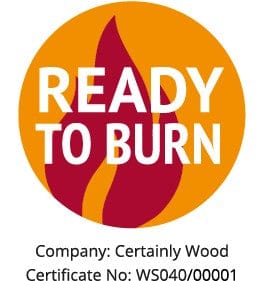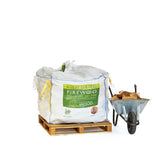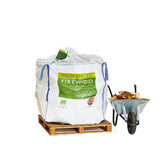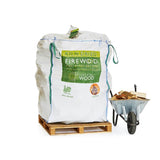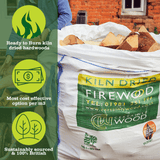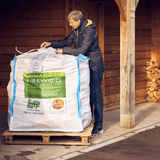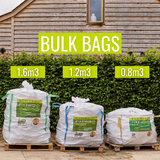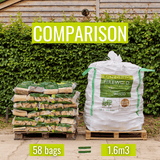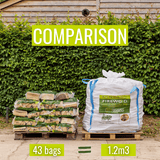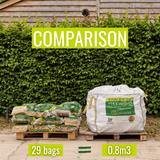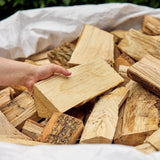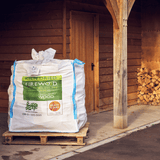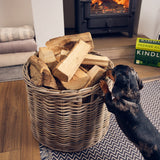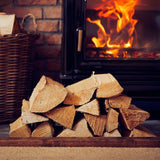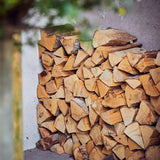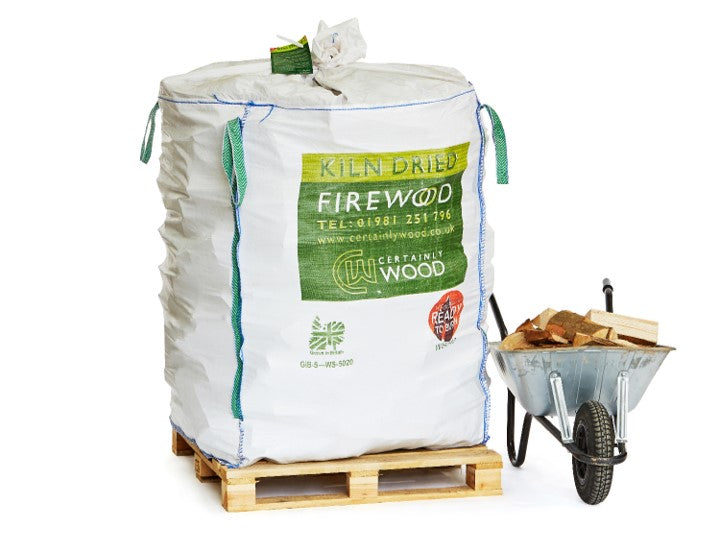
Kiln Dried Logs In Bulk Bags
 100% 'Ready to Burn' assured British kiln dried hardwood logs
100% 'Ready to Burn' assured British kiln dried hardwood logs For immediate burning on all wood-burning appliances
For immediate burning on all wood-burning appliances  Kiln dried logs (below 20% moisture content) give the ultimate clean burn with maximum heat output
Kiln dried logs (below 20% moisture content) give the ultimate clean burn with maximum heat output Earn loyalty points on your purchases
Earn loyalty points on your purchases
This product has an estimated lead time of 7-10 working days.
This is our smallest bulk bag (containing roughly 29 little bags) which is securely strapped to a pallet for safe delivery. We recommend you don't keep your logs stored in the bag but stacked in a log store or garage which has sufficient airflow. For this size bulk bag, we recommend 3 boxes of kiln dried kindling and 1 box of 24 Flamers natural firelighters or 3 boxes of KindleFlamers natural firelighters 18 packs with which you need no kindling.
Our Ready to Burn logs which are dried below 20% moisture provide you with the ultimate burn quality with maximum heat output. The kiln drying process in our wood-fired kilns removes most of the water for you, down to below an average of 20% moisture content which ensures your stove glass is kept clean. The lack of moisture in the logs will also prevent a build-up of soot or tar in your chimney or flue and because you get so much heat output, you will actually need fewer logs, than if you were to buy seasoned logs, thus providing you with great value for money. You can also expect a consistent product that you can rely on every time, unlike ‘seasoned logs’ which can be inconsistent in terms of their moisture content due to the natural and varied drying process. Stove manufacturers recommend the standard length of 25cm kiln dried logs to fit 99% of wood burning or multi-fuel stoves, but you can choose from larger 35cm and 50cm logs if your wood burner is large enough. If you want very large logs, you can also choose our chunky logs which are much larger in diameter.
What are kiln dried logs?
This is firewood that has been force-dried in kilns in a short space of time rather than dried naturally more commonly known as ‘seasoning’ over a period of time. The aim is to get the logs to below 20% moisture content which is what they need for the optimum burn. We only process timber which has been sourced from sustainably managed woodlands which means we only take thinnings which are required for healthy woodlands.
The time taken to dry logs in kilns can vary depending on the drying system used, but typically it will take about 7-10 days in a chamber which runs at around 60 – 70 °C. At Certainly Wood we have a very unique drying system which runs at much higher temperatures with fans to circulate the hot air. Our kilns can dry wood in approx. 50-hour cycles and each time, we put 18 tonnes into a kiln and take 12 tonnes out – therefore removing 6 tonnes (6,000 litres) of water! For more on how we do this, watch the video below:
Are kiln dried logs worth it?
Yes, very much so, but they will almost always be more expensive because they are ready to burn and the majority of the water is already removed for you. Being so dry, hopefully below 20% moisture content will mean you will get far more heat output and therefore if burning in an efficient stove it will mean you will use far less wood. So, it's actually far better value for money. The other benefit is that you should never have to overpay your chimney sweep to spend time removing tar from your chimney or flue!
Here are 10 reasons why kiln dried logs are worth the money.How do you store kiln dried logs?
The way you store your kiln dried logs is a lot more important than you may think, and if you have a wood-burning appliance, it's crucial you store your firewood correctly to ensure you receive the best output from your wood burner. But why is it so important?
Failure to store your firewood correctly can result in a host of issues, ranging from wet wood, mouldy logs and even bug infestations. For a clean and efficient burn, logs should have a moisture content below 20%, as per the Ready to Burn scheme, so it is imperative to keep your firewood as clean and dry as possible. In this blog, we will discuss the best ways to store your logs and share all our tips & tricks regarding firewood storage.
Find all the answers in our "The Best Ways to Store your Kiln Dried Logs" blog.
Which is the best kiln dried wood?
Naturally, we will say British sourced every time as we don't import any logs and we believe British should be supported for the obvious reasons:
- Reducing ‘log miles’, therefore reduced CO2 emissions of transport.
- Supporting British forestry and the relevant jobs
- Ensuring British woodlands are properly managed by taking regular thinnings for firewood and therefore improving overall health and wellbeing of the flora and fauna of that woodland.
- Reducing the risk of disease transfer from imported timber. Ash dieback originated from the continent and this disease is now destroying our beautiful ash trees. The ash borer beetle is heading this way too – it will only take one infected tree!
However, there are a lot of imported kiln dried logs on the market and much of it is of good quality and Woodsure ‘Ready to Burn’ approved. However, whilst the likes of silver birch or alder provide a very nice even and consistent sample of logs and burn very nicely, they will burn 20-25% faster than mixed hardwood British logs such as oak logs, ash logs and beech logs because the wood is less dense and more like softwood. That is a massive difference in terms of the amount of wood you will burn, so be careful when you select what you buy. It might seem cheaper on the face of it, but you will end up buying more logs for the same amount of heat output, therefore costing you more.
Here is a video explaining some of the species that you might encounter!
Does kiln dried wood burn faster?
This a common question and the answer is yes, but only if burnt on an open fire which has no air control, but it is still recommended to burn kiln dried logs on open fires to avoid tarring up the chimney. Those who think mixing wet logs with kiln dried is good to slow the burn then this is completely false economy as not only will you reduce the heat output, therefore needing more logs, but also you will tar the chimney.
In a wood burning stove, kiln dried logs burn much more slowly and cleanly and provide a huge amount of heat – nothing can be more efficient. In a modern Ecodesign stove the importance of logs below 20% becomes even more evident.
Our MD Nic Snell discusses this topic in our "Do Kiln Dried Logs Burn Too Quickly?" blog.
This bulk bag is securely strapped to the pallet for safe delivery. We recommend that kiln dried logs are not stored in the bag, but stacked in a log store or garage. For this size bulk bag, we recommend 3 boxes of kiln dried kindling and 1 box of 24 Flamers natural firelighters
Our Ready to Burn logs which are dried below 20% moisture provide you with the ultimate burn quality with maximum heat output. The kiln drying process in our wood-fired kilns removes most of the water for you, down to below an average of 20% moisture content which ensures your stove glass is kept clean. The lack of moisture in the logs will also prevent a build-up of soot or tar in your chimney or flue and because you get so much heat output, you will actually need fewer logs, than if you were to buy seasoned logs, thus providing you with great value for money. You can also expect a consistent product that you can rely on every time, unlike ‘seasoned logs’ which can be inconsistent in terms of their moisture content due to the natural and varied drying process. Stove manufacturers recommend the standard length of 25cm kiln dried logs to fit 99% of wood burning or multi-fuel stoves, but you can choose from larger 35cm and 50cm logs if your wood burner is large enough. If you want very large logs, you can also choose our chunky logs which are much larger in diameter.
What are kiln dried logs?
This is firewood that has been force-dried in kilns in a short space of time rather than dried naturally more commonly known as ‘seasoning’ over a period of time. The aim is to get the logs to below 20% moisture content which is what they need to be for the optimum burn. We only process timber which has been sourced from sustainably managed woodlands which means we only take thinnings which are required for healthy woodlands.
The time taken to dry logs in kilns can vary depending on the drying system used, but typically it will take about 7-10 days in a chamber which runs at around 60 – 70 °C. At Certainly Wood we have a unique drying system which runs at much higher temperatures with fans to circulate the hot air. Our kilns can dry wood in approx. 50-hour cycles and each time, we put 18 tonnes into a kiln and take 12 tonnes out – therefore removing 6 tonnes (6,000 litres) of water!
Watch the video on how we process our kiln dried logs.
Are kiln dried logs worth it?
Yes, very much so, but they will almost always be more expensive because they are ready to burn and the majority of the water is already removed for you. Being so dry, below 20% moisture content will mean you will get far more heat output and therefore if burning in an efficient stove it will mean you will use far less wood. So, it's actually far better value for money. The other benefit is that you should never have to overpay your chimney sweep to spend time removing tar from your chimney or flue!
Here are 10 reasons why kiln dried logs are worth the money.
How do you store kiln dried logs?
If space permits, the ideal place to store your kiln dried logs, to keep them at their best for longer, is in a purpose-built log store. Fundamentally, logs should be stored off the ground, in a well-ventilated area and covered; this is why purpose-built log stores are the perfect environment for your logs as all of the above are considered. Your log store should be strategically located with access to sunlight, good airflow easy access for delivery vehicles, and, more importantly, a short distance from the house (to save the long trips in the winter!)
Read our "Best Ways to Store Kiln Dried Logs" blog.
Which is the best kiln dried wood?
Naturally, we will say British sourced every time as we don't import any logs and we believe British should be supported for the obvious reasons:
- Reducing ‘log miles’, therefore reduced CO2 emissions of transport.
- Supporting British forestry and the relevant jobs
- Ensuring British woodlands are properly managed by taking regular thinnings for firewood and therefore improving overall health and wellbeing of the flora and fauna of that woodland.
- Reducing the risk of disease transfer from imported timber. Ash dieback originated from the continent and this disease is now destroying our beautiful ash trees. The ash borer beetle is heading this way too – it will only take one infected tree!
However, there are a lot of imported kiln dried logs on the market; much of it is of good quality and Woodsure ‘Ready to Burn’ approved. However, whilst the likes of silver birch or alder provide a very nice even and consistent sample of logs and burn very nicely, they will burn 20-25% faster than mixed hardwood British logs such as oak logs, ash logs and beech logs because the wood is less dense and more like softwood. That is a massive difference in terms of the amount of wood you will burn, so be careful when you select what you buy. It might seem cheaper on the face of it, but you will end up buying more logs for the same amount of heat output, therefore costing you more.
Here is a video explaining some of the species that you might encounter!
Does kiln dried wood burn faster?
This a common question and the answer is yes, but only if burnt on an open fire which has no air control, it is still recommended to burn kiln dried logs on open fires to avoid tarring up the chimney. Those who think mixing wet logs with kiln dried is good to slow the burn then this is completely false economy as not only will you reduce the heat output, therefore needing more logs, but also you will tar the chimney.
In a wood-burning stove, kiln dried logs burn much more slowly and cleanly and provide a huge amount of heat – nothing can be more efficient. In a modern Ecodesign stove the importance of logs below 20% becomes even more evident.
Read more about this topic in our "Do kiln dried logs burn too quickly?" blog.
We recommend that kiln dried logs are not stored in the bag, but stacked in a log store or garage. For this size of bag, we would recommend 4 boxes of kindling and 1 box of 50 Flamers.
Our Ready to Burn logs which are dried below 20% moisture provide you with the ultimate burn quality with maximum heat output. The kiln drying process in our wood-fired kilns removes most of the water for you, down to below an average of 20% moisture content which ensures your stove glass is kept clean. The lack of moisture in the logs will also prevent a build-up of soot or tar in your chimney or flue and because you get so much heat output, you will actually need fewer logs, than if you were to buy seasoned logs, thus providing you with great value for money. You can also expect a consistent product that you can rely on every time, unlike ‘seasoned logs’ which can be inconsistent in terms of their moisture content due to the natural and varied drying process. Stove manufacturers recommend the standard length of 25cm kiln dried logs to fit 99% of wood burning or multi-fuel stoves, but you can choose from larger 35cm and 50cm logs if your wood burner is large enough. If you want very large logs, you can also choose our chunky logs which are much larger in diameter.
What are kiln dried logs?
This is firewood that has been force-dried in kilns in a short space of time rather than dried naturally more commonly known as ‘seasoning’ over a period of time. The aim is to get the logs to below 20% moisture content which is what they need to be for the optimum burn. We only process timber which has been sourced from sustainably managed woodlands which means we only take thinnings which are required for healthy woodlands.
The time taken to dry logs in kilns can vary depending on the drying system used, but typically it will take about 7-10 days in a chamber which runs at around 60 – 70 °C. At Certainly Wood we have a very unique drying system which runs at much higher temperatures with fans to circulate the hot air. Our kilns can dry wood in approx. 50-hour cycles and each time, we put 18 tonnes into a kiln and take 12 tonnes out – therefore removing 6 tonnes (6,000 litres) of water!
Are kiln dried logs worth it?
Yes, very much so, but they will almost always be more expensive because they are ready to burn and the majority of the water is already removed for you. Being so dry, hopefully below 20% moisture content will mean you will get far more heat output and therefore if burning in an efficient stove it will mean you will use far less wood. So, it's actually far better value for money. The other benefit is that you should never have to overpay your chimney sweep to spend time removing tar from your chimney or flue!
Here are 10 reasons why kiln dried logs are worth it.
How do you store kiln dried logs?
If space permits, the ideal place to store your kiln dried logs, to keep them at their best for longer, is in a purpose-built log store. Fundamentally, logs should be stored off the ground, in a well-ventilated area and covered; this is why purpose-built log stores are the perfect environment for your logs as all of the above are considered. Your log store should be strategically located with access to sunlight, good airflow easy access for delivery vehicles, and, more importantly, a short distance from the house (to save the long trips in the winter!)
Read more about the best ways to store your kiln dried logs
Which is the best kiln dried wood?
Naturally, we will say British sourced every time as we don't import any logs and we believe British should be supported for the obvious reasons:
- Reducing ‘log miles’, therefore reduced CO2 emissions of transport.
- Supporting British forestry and the relevant jobs
- Ensuring British woodlands are properly managed by taking regular thinnings for firewood and therefore improving overall health and wellbeing of the flora and fauna of that woodland.
- Reducing the risk of disease transfer from imported timber. Ash dieback originated from the continent and this disease is now destroying our beautiful ash trees. The ash borer beetle is heading this way too – it will only take one infected tree!
However, there are a lot of imported kiln dried logs on the market and much of it is of good quality and Woodsure ‘Ready to Burn’ approved. However, whilst the likes of silver birch or alder provide a very nice even and consistent sample of logs and burn very nicely, they will burn 20-25% faster than mixed hardwood British logs such as oak logs, ash logs and beech logs because the wood is less dense and more like softwood. That is a massive difference in terms of the amount of wood you will burn, so be careful when you select what you buy. It might seem cheaper on the face of it, but you will end up buying more logs for the same amount of heat output, therefore costing you more.
Does kiln dried wood burn faster?
This a common question and the answer is yes, but only if burnt on an open fire which has no air control, it is still recommended to burn kiln dried logs on open fires to avoid tarring up the chimney. Those who think mixing wet logs with kiln dried is good to slow the burn then this is completely false economy as not only will you reduce the heat output, therefore needing more logs, but also you will tar the chimney.
In a wood burning stove, kiln dried logs burn much more slowly and cleanly and provide a huge amount of heat – nothing can be more efficient. In a modern Ecodesign stove the importance of logs below 20% becomes even more evident.
Our MD Nic Snell discusses this topic in our "Do kiln dried logs burn too quickly" blog.
We recommend that kiln dried logs are not stored in the bag, but stacked in a log store or garage. For this size of bag, we would recommend 4 boxes of kindling and 1 box of 50 Flamers.
Kiln dried logs provide you with the ultimate burn quality with maximum heat output. The kiln drying process in our wood-fired kilns removes most of the water for you, down to below an average of 20% moisture content. Burning kiln dried logs will ensure your stove glass is kept clean and will prevent a build-up of soot or tar in your chimney or flue and because you get so much heat output, you will actually need less kiln dried logs, than if you were to buy seasoned logs, thus providing you with great value for money. Kiln dried logs also provide you with a consistent product that you can rely on every time, unlike ‘seasoned logs’ which can be inconsistent in terms of their moisture content due to the natural and varied drying process. The standard length of 25cm kiln dried logs is recommended by stove manufacturers to fit 99% of wood burning or multi-fuel stoves.
We recommend that kiln dried logs are not stored in the bag, but stacked in a log store or garage. For this size of bag, we would recommend 4 boxes of kindling and 1 box of 50 Flamers.
Our Ready to Burn logs which are dried below 20% moisture provide you with the ultimate burn quality with maximum heat output. The kiln drying process in our wood-fired kilns removes most of the water for you, down to below an average of 20% moisture content which ensures your stove glass is kept clean. The lack of moisture in the logs will also prevent a build-up of soot or tar in your chimney or flue and because you get so much heat output, you will actually need fewer logs, than if you were to buy seasoned logs, thus providing you with great value for money. You can also expect a consistent product that you can rely on every time, unlike ‘seasoned logs’ which can be inconsistent in terms of their moisture content due to the natural and varied drying process. The standard length of 25cm kiln dried logs is recommended by stove manufacturers to fit 99% of wood burning or multi-fuel stoves, but you can choose from larger 35cm and 50cm logs if your wood burner is large enough. If you want very large logs, you can also choose our chunky logs which are much larger in diameter.
What are kiln dried logs?
This is firewood that has been force-dried in kilns in a short space of time rather than dried naturally more commonly known as ‘seasoning’ over a period of time. The aim is to get the logs to below 20% moisture content which is what they need for the optimum burn. We only process timber which has been sourced from sustainably managed woodlands which means we only take thinnings which are required for healthy woodlands.
The time taken to dry logs in kilns can vary depending on the drying system used, but typically it will take about 7-10 days in a chamber which runs at around 60 – 70 °C. At Certainly Wood we have a very unique drying system which runs at much higher temperatures with fans to circulate the hot air. Our kilns can dry wood in approx. 50-hour cycles and each time, we put 18 tonnes into a kiln and take 12 tonnes out – therefore removing 6 tonnes (6,000 litres) of water!
Are kiln dried logs worth it?
Yes, very much so, but they will almost always be more expensive because they are ready to burn and the majority of the water is already removed for you. Being so dry, hopefully below 20% moisture content will mean you will get far more heat output and therefore if burning in an efficient stove it will mean you will use far less wood. So, it's actually far better value for money. The other benefit is that you should never have to overpay your chimney sweep to spend time removing tar from your chimney or flue!
Here are 10 reasons why kiln dried logs are worth it.
How do you store kiln dried logs?
If space permits, the ideal place to store your kiln dried logs, to keep them at their best for longer, is in a purpose-built log store. Fundamentally, logs should be stored off the ground, in a well-ventilated area and covered; this is why purpose-built log stores are the perfect environment for your logs as all of the above are considered. Your log store should be strategically located with access to sunlight, good airflow easy access for delivery vehicles, and, more importantly, a short distance from the house (to save the long trips in the winter!)
Read more about the best ways to store your kiln dried logs
Which is the best kiln dried wood?
Naturally, we will say British sourced every time as we don't import any logs and we believe British should be supported for the obvious reasons:
- Reducing ‘log miles’, therefore reduced CO2 emissions of transport.
- Supporting British forestry and the relevant jobs
- Ensuring British woodlands are properly managed by taking regular thinnings for firewood and therefore improving overall health and wellbeing of the flora and fauna of that woodland.
- Reducing the risk of disease transfer from imported timber. Ash dieback originated from the continent and this disease is now destroying our beautiful ash trees. The ash borer beetle is heading this way too – it will only take one infected tree!
However, there are a lot of imported kiln dried logs on the market; much of it is of good quality and Woodsure ‘Ready to Burn’ approved. However, whilst the likes of silver birch or alder provide a very nice even and consistent sample of logs and burn very nicely, they will burn 20-25% faster than mixed hardwood British logs such as oak logs, ash logs and beech logs because the wood is less dense and more like softwood. That is a massive difference in terms of the amount of wood you will burn, so be careful when you select what you buy. It might seem cheaper on the face of it, but you will end up buying more logs for the same amount of heat output, therefore costing you more.
Does kiln dried wood burn faster?
This a common question and the answer is yes, but only if burnt on an open fire which has no air control, it is still recommended to burn kiln dried logs on open fires to avoid tarring up the chimney. Those who think mixing wet logs with kiln dried is good to slow the burn then this is completely false economy as not only will you reduce the heat output, therefore needing more logs, but also you will tar the chimney.
In a wood burning stove, kiln dried logs burn much more slowly and cleanly and provide a huge amount of heat – nothing can be more efficient. In a modern Ecodesign stove the importance of logs below 20% becomes even more evident.
Our MD Nic Snell discusses this topic in our "Do kiln dried logs burn too quickly" blog.
This is the most popular size for home delivery. This bulk bag is securely strapped to the pallet for safe delivery. We recommend that kiln dried logs are not stored in the bag, but stacked in a log store or garage. For this size of the bag, we would recommend 6 boxes of kindling and 2 boxes of 50 Flamers.
Our Ready to Burn logs which are dried below 20% moisture provide you with the ultimate burn quality with maximum heat output. The kiln drying process in our wood-fired kilns removes most of the water for you, down to below an average of 20% moisture content which ensures your stove glass is kept clean. The lack of moisture in the logs will also prevent a build-up of soot or tar in your chimney or flue and because you get so much heat output, you will actually need fewer logs, than if you were to buy seasoned logs, thus providing you with great value for money. You can also expect a consistent product that you can rely on every time, unlike ‘seasoned logs’ which can be inconsistent in terms of their moisture content due to the natural and varied drying process. The standard length of 25cm kiln dried logs is recommended by stove manufacturers to fit 99% of wood burning or multi-fuel stoves, but you can choose from larger 35cm and 50cm logs if your wood burner is large enough. If you want very large logs, you can also choose our chunky logs which are much larger in diameter.
What are kiln dried logs?
This is firewood that has been force-dried in kilns in a short space of time rather than dried naturally more commonly known as ‘seasoning’ over a period of time. The aim is to get the logs to below 20% moisture content which is what they need to be for the optimum burn. We only process timber which has been sourced from sustainably managed woodlands which means we only take thinnings which are required for healthy woodlands.
The time taken to dry logs in kilns can vary depending on the drying system used, but typically it will take about 7-10 days in a chamber which runs at around 60 – 70 °C. At Certainly Wood we have a very unique drying system which runs at much higher temperatures with fans to circulate the hot air. Our kilns can dry wood in approx. 50-hour cycles and each time, we put 18 tonnes into a kiln and take 12 tonnes out – therefore removing 6 tonnes (6,000 litres) of water!
Are kiln dried logs worth it?
Yes, very much so, but they will almost always be more expensive because they are ready to burn and the majority of the water is already removed for you. Being so dry, hopefully below 20% moisture content will mean you will get far more heat output and therefore if burning in an efficient stove it will mean you will use far less wood. So, it's actually far better value for money. The other benefit is that you should never have to overpay your chimney sweep to spend time removing tar from your chimney or flue!
Here are 10 reasons why kiln dried logs are worth it.
How do you store kiln dried logs?
If space permits, the ideal place to store your kiln dried logs, to keep them at their best for longer, is in a purpose-built log store. Fundamentally, logs should be stored off the ground, in a well-ventilated area and covered; this is why purpose-built log stores are the perfect environment for your logs as all of the above are considered. Your log store should be strategically located with access to sunlight, good airflow and easy access for delivery vehicles, and, more importantly, a short distance from the house (to save the long trips in the winter!)
Read more about the best ways to store your kiln dried logs
Which is the best kiln dried wood?
Naturally, we will say British sourced every time as we don't import any logs and we believe British should be supported for the obvious reasons:
- Reducing ‘log miles’, therefore reduced CO2 emissions of transport.
- Supporting British forestry and the relevant jobs
- Ensuring British woodlands are properly managed by taking regular thinnings for firewood and therefore improving overall health and wellbeing of the flora and fauna of that woodland.
- Reducing the risk of disease transfer from imported timber. Ash dieback originated from the continent and this disease is now destroying our beautiful ash trees. The ash borer beetle is heading this way too – it will only take one infected tree!
However, there are a lot of imported kiln dried logs on the market; much of it is of good quality and Woodsure ‘Ready to Burn’ approved. However, whilst the likes of silver birch or alder provide a very nice even and consistent sample of logs and burn very nicely, they will burn 20-25% faster than mixed hardwood British logs such as oak logs, ash logs and beech logs because the wood is less dense and more like softwood. That is a massive difference in terms of the amount of wood you will burn, so be careful when you select what you buy. It might seem cheaper on the face of it, but you will end up buying more logs for the same amount of heat output, therefore costing you more.
Does kiln dried wood burn faster?
This a common question and the answer is yes, but only if burnt on an open fire which has no air control, it is still recommended to burn kiln dried logs on open fires to avoid tarring up the chimney. Those who think mixing wet logs with kiln dried is good to slow the burn then this is completely false economy as not only will you reduce the heat output, therefore needing more logs, but also you will tar the chimney.
In a wood burning stove, kiln dried logs burn much more slowly and cleanly and provide a huge amount of heat – nothing can be more efficient. In a modern Ecodesign stove the importance of logs below 20% becomes even more evident.
Our MD Nic Snell discusses this topic in our "Do kiln dried logs burn too quickly" blog.
This is the most popular size for home delivery. This bulk bag is securely strapped to the pallet for safe delivery. We recommend that kiln dried logs are not stored in a bag, but stacked in a log store or garage. For this size of bag, we would recommend 6 boxes of kindling and 2 boxes of 50 Flamers.
Our Ready to Burn logs which are dried below 20% moisture provide you with the ultimate burn quality with maximum heat output. The kiln drying process in our wood-fired kilns removes most of the water for you, down to below an average of 20% moisture content which ensures your stove glass is kept clean. The lack of moisture in the logs will also prevent a build-up of soot or tar in your chimney or flue and because you get so much heat output, you will actually need fewer logs, than if you were to buy seasoned logs, thus providing you with great value for money. You can also expect a consistent product that you can rely on every time, unlike ‘seasoned logs’ which can be inconsistent in terms of their moisture content due to the natural and varied drying process. The standard length of 25cm kiln dried logs is recommended by stove manufacturers to fit 99% of wood burning or multi-fuel stoves, but you can choose from larger 35cm and 50cm logs if your wood burner is large enough. If you want very large logs, you can also choose our chunky logs which are much larger in diameter.
What are kiln dried logs?
This is firewood that has been force-dried in kilns in a short space of time rather than dried naturally more commonly known as ‘seasoning’ over a period of time. The aim is to get the logs to below 20% moisture content which is what they need to be for the optimum burn. We only process timber which has been sourced from sustainably managed woodlands which means we only take thinnings which are required for healthy woodlands.
The time taken to dry logs in kilns can vary depending on the drying system used, but typically it will take about 7-10 days in a chamber which runs at around 60 – 70 °C. At Certainly Wood we have a very unique drying system which runs at much higher temperatures with fans to circulate the hot air. Our kilns can dry wood in approx. 50-hour cycles and each time, we put 18 tonnes into a kiln and take 12 tonnes out – therefore removing 6 tonnes (6,000 litres) of water!
Are kiln dried logs worth it?
Yes, very much so, but they will almost always be more expensive because they are ready to burn and the majority of the water is already removed for you. Being so dry, hopefully below 20% moisture content, will mean you will get far more heat output and therefore if burning in an efficient stove it will mean you will use far less wood. So, it's actually far better value for money. The other benefit is that you should never have to overpay your chimney sweep to spend time removing tar from your chimney or flue!
Here are 10 reasons why kiln dried logs are worth it.
How to store kiln dried logs?
If space permits, the ideal place to store your kiln dried logs, to keep them at their best for longer, is in a purpose-built log store. Fundamentally, logs should be stored off the ground, in a well-ventilated area and covered; this is why purpose-built log stores are the perfect environment for your logs as all of the above are considered. Your log store should be strategically located with access to sunlight, good airflow easy access for delivery vehicles, and, more importantly, a short distance from the house (to save the long trips in the winter!)
Read more about the best ways to store your kiln dried logs
Which is the best kiln dried wood?
Naturally, we will say British sourced every time as we don't import any logs and we believe British should be supported for the obvious reasons:
- Reducing ‘log miles’, therefore reduced CO2 emissions of transport.
- Supporting British forestry and the relevant jobs
- Ensuring British woodlands are properly managed by taking regular thinnings for firewood and therefore improving overall health and wellbeing of the flora and fauna of that woodland.
- Reducing the risk of disease transfer from imported timber. Ash dieback originated from the continent and this disease is now destroying our beautiful ash trees. The ash borer beetle is heading this way too – it will only take one infected tree!
However, there are a lot of imported kiln dried logs on the market; much of it is of good quality and Woodsure ‘Ready to Burn’ approved. However, whilst the likes of silver birch or alder provide a very nice even and consistent sample of logs and burn very nicely, they will burn 20-25% faster than mixed hardwood British logs such as oak logs, ash logs and beech logs because the wood is less dense and more like softwood. That is a massive difference in terms of the amount of wood you will burn, so be careful when you select what you buy. It might seem cheaper on the face of it, but you will buy more logs for the same amount of heat output, therefore costing you more.
Does kiln dried wood burn faster?
This a common question and the answer is yes, but only if burnt on an open fire which has no air control, it is still recommended to burn kiln dried logs on open fires to avoid tarring up the chimney. Those who think mixing wet logs with kiln dried is good to slow the burn then this is completely false economy as not only will you reduce the heat output, therefore needing more logs, but also you will tar the chimney.
In a wood burning stove, kiln dried logs burn much more slowly and cleanly and provide a huge amount of heat – nothing can be more efficient. In a modern Ecodesign stove the importance of logs below 20% becomes even more evident.
Our MD Nic Snell discusses this topic in our "Do kiln dried logs burn too quickly" blog.
This is the most popular size for home delivery. This bulk bag is securely strapped to the pallet for safe delivery. We recommend that kiln dried logs are not stored in the bag, but stacked in a log store or garage. For this size of bag, we would recommend 6 boxes of kindling and 2 boxes of 50 Flamers.
Our Ready to Burn logs which are dried below 20% moisture provide you with the ultimate burn quality with maximum heat output. The kiln drying process in our wood-fired kilns removes most of the water for you, down to below an average of 20% moisture content which ensures your stove glass is kept clean. The lack of moisture in the logs will also prevent a build-up of soot or tar in your chimney or flue and because you get so much heat output, you will actually need fewer logs, than if you were to buy seasoned logs, thus providing you with great value for money. You can also expect a consistent product that you can rely on every time, unlike ‘seasoned logs’ which can be inconsistent in terms of their moisture content due to the natural and varied drying process. The standard length of 25cm kiln dried logs is recommended by stove manufacturers to fit 99% of wood burning or multi-fuel stoves, but you can choose from larger 35cm and 50cm logs if your wood burner is large enough. If you want very large logs, you can also choose our chunky logs which are much larger in diameter.
What are kiln dried logs?
This is firewood that has been force-dried in kilns in a short space of time rather than dried naturally more commonly known as ‘seasoning’ over a period of time. The aim is to get the logs to below 20% moisture content which is what they need to be for the optimum burn. We only process timber which has been sourced from sustainably managed woodlands which means we only take thinnings which are required for healthy woodlands.
The time taken to dry logs in kilns can vary depending on the drying system used, but typically it will take about 7-10 days in a chamber which runs at around 60 – 70 °C. At Certainly Wood we have a very unique drying system which runs at much higher temperatures with fans to circulate the hot air. Our kilns can dry wood in approx. 50-hour cycles and each time, we put 18 tonnes into a kiln and take 12 tonnes out – therefore removing 6 tonnes (6,000 litres) of water!
Are kiln dried logs worth it?
Yes, very much so, but they will almost always be more expensive because they are ready to burn and the majority of the water is already removed for you. Being so dry, hopefully below 20% moisture content, will mean you will get far more heat output and therefore if burning in an efficient stove it will mean you will use far less wood. So, it's actually far better value for money. The other benefit is that you should never have to overpay your chimney sweep to spend time removing tar from your chimney or flue!
Here are 10 reasons why kiln dried logs are worth it.
How do you store kiln dried logs?
If space permits, the ideal place to store your kiln dried logs, to keep them at their best for longer, is in a purpose-built log store. Fundamentally, logs should be stored off the ground, in a well-ventilated area and covered; this is why purpose-built log stores are the perfect environment for your logs as all of the above are considered. Your log store should be strategically located with access to sunlight, good airflow easy access for delivery vehicles, and, more importantly, a short distance from the house (to save the long trips in the winter!)
Read more about the best ways to store your kiln dried logs
Which is the best kiln dried wood?
Naturally, we will say British sourced every time as we don't import any logs and we believe British should be supported for the obvious reasons:
- Reducing ‘log miles’, therefore reduced CO2 emissions of transport.
- Supporting British forestry and the relevant jobs
- Ensuring British woodlands are properly managed by taking regular thinnings for firewood and therefore improving overall health and wellbeing of the flora and fauna of that woodland.
- Reducing the risk of disease transfer from imported timber. Ash dieback originated from the continent and this disease is now destroying our beautiful ash trees. The ash borer beetle is heading this way too – it will only take one infected tree!
However, there are a lot of imported kiln dried logs on the market; much of it is of good quality and Woodsure ‘Ready to Burn’ approved. However, whilst the likes of silver birch or alder provide a very nice even and consistent sample of logs and burn very nicely, they will burn 20-25% faster than mixed hardwood British logs such as oak logs, ash logs and beech logs because the wood is less dense and more like softwood. That is a massive difference in terms of the amount of wood you will burn, so be careful when you select what you buy. It might seem cheaper on the face of it, but you will end up buying more logs for the same amount of heat output, therefore costing you more.
Does kiln dried wood burn faster?
This a common question and the answer is yes, but only if burnt on an open fire which has no air control, it is still recommended to burn kiln dried logs on open fires to avoid tarring up the chimney. Those who think mixing wet logs with kiln dried is good to slow the burn then this is completely false economy as not only will you reduce the heat output, therefore needing more logs, but also you will tar the chimney.
In a wood burning stove, kiln dried logs burn much more slowly and cleanly and provide a huge amount of heat – nothing can be more efficient. In a modern Ecodesign stove the importance of logs below 20% becomes even more evident.
Our MD Nic Snell discusses this topic in our "Do kiln dried logs burn too quickly" blog.
| Bag Size | Log Size | Price | Price Per M3 |
|---|---|---|---|
| Small Bulk Bag 1.2m3 | 50cm (+/- 10%) | £274.00 | £228.33 |
| 35cm (+/- 10%) | £274.00 | £228.33 | |
| 25cm (standard) | £274.00 | £228.33 | |
| Large Bulk Bag 1.6m3 | 50cm (+/- 10%) | £340.00 | £212.50 |
| 35cm (+/- 10%) | £340.00 | £212.50 | |
| 25cm (standard) | £340.00 | £212.50 | |
| Extra Small Bulk Bag 0.8m3 | 35cm (+/- 10%) | £219.00 | £273.75 |
| 25cm (standard) | £219.00 | £273.75 |
::delivery::
Please Note: Our carriers are contracted to do a kerbside delivery only.
Your property needs to have excellent delivery access and a smooth level surface for unloading. Please consider the following: whether the lorry can get to your property due to parked cars or other narrow access points, road closures nearby or overhanging branches. Please refer to our Terms & Conditions as charges may apply if access is not possible. Please let us know if you anticipate any problems so that we can prevent any unnecessary charges.
The minimum delivery requirement is kerbside, but our carriers will endeavour to deliver as close to your desired location as possible.
Watch our delivery video HERE.
| Bag Size |
|
|---|---|
| Log Size: | 25cm (standard) |
| Origin: | British |
| Pack Size: |
|
| Log Length: | 25cm (9 ¾”) is the standard length, Tolerance on length is +/- 10% |
| Log Diameter: |
|
| Moisture Content: | Average 20% |
| Brash Content: |
|
| Estimated Lead Time: | 3-5 working days |
| Bag Size: |
|
|---|---|
| Log Size: |
|
| Origin: | British |
| Pack Size: |
|
| Log Length: |
|
| Log Diameter: |
|
| Moisture Content: | Average 20% |
| Brash Content: | Average 20% |
| Estimated Lead Time: | 3-5 working days |
| Bag Size |
|
|---|---|
| Log Size: | 25cm (standard) |
| Origin: | British |
| Pack Size: |
|
| Log Length: | 25cm (9 ¾”) is the standard length, Tolerance on length is +/- 10% |
| Log Diameter: |
|
| Moisture Content: | Average 20% |
| Brash Content: |
|
| Estimated Lead Time: | 3-5 working days |
::packaging::
Pallet: Recycle at the local recycling centre or reuse with these pallet re-purposing ideas
Bulk Bag: Made from 30% recycled material & 100% recyclable. Recycle at the local recycling centre.
| Bag Size: |
|
|---|---|
| Log Size: |
|
| Origin: | British |
| Pack Size: |
|
| Log Length: |
|
| Log Diameter: |
8-20cm (4-8") measured across the widest point of the log. Tolerance on diameter +/- 10%
|
| Moisture Content: | Average 20% |
| Brash Content: |
|
| Estimated Lead Time: | 3-5 working days |
| Bag Size |
|
|---|---|
| Log Size: | 50cm |
| Origin: | British |
| Pack Size: |
|
| Log Length: | 50cm (13 ¾”) is the standard length, Tolerance on length is +/- 10% |
| Log Diameter: |
|
| Moisture Content: | Average 20% |
| Brash Content: |
|
| Estimated Lead Time: | 3-5 working days |
::packaging::
Pallet: Recycle at the local recycling centre or reuse with these pallet re-purposing ideas
Bulk Bag: Made from 30% recycled material & 100% recyclable. Recycle at the local recycling centre.
| Bag Size: |
Large Bulk Bag 1.6m3
|
|---|---|
| Log Size: |
|
| Origin: | British |
| Pack Size: |
1.6m3 (loose fill) – Contains the equivalent of approx. 58 small bags of kiln dried firewood
|
| Log Length: |
25cm (9 ¾”) is the standard length, but also available in 35cm (13 ¾”) Tolerance on lengths +/- 10%
|
| Log Diameter: |
|
| Moisture Content: | Average 20% |
| Brash Content: |
|
| Estimated Lead Time: | 3-5 working days |
| Bag Size: |
Large Bulk Bag 1.6m3
|
|---|---|
| Log Size: |
|
| Origin: | British |
| Pack Size: |
1.6m3 (loose fill) – Contains the equivalent of approx. 58 small bags of kiln dried firewood
|
| Log Length: |
|
| Log Diameter: |
8-20cm (4-8") measured across the widest point of the log. Tolerance on diameter +/- 10%
|
| Moisture Content: | Average 20% |
| Brash Content: |
|
| Estimated Lead Time: | 3-5 working days |
| Bag Size: |
Large Bulk Bag 1.6m3
|
|---|---|
| Log Size: |
|
| Origin: | British |
| Pack Size: |
1.6m3 (loose fill) – Contains the equivalent of approx. 58 small bags of kiln dried firewood
|
| Log Length: |
|
| Log Diameter: |
8-20cm (4-8") measured across the widest point of the log. Tolerance on diameter +/- 10%
|
| Moisture Content: | Average 20% |
| Brash Content: |
|
| Estimated Lead Time: | 3-5 working days |
Please Note: Our carriers are contracted to do a kerbside delivery only.
Your property needs to have excellent delivery access and a smooth level surface for unloading. Please consider the following: whether the lorry can get to your property due to parked cars or other narrow access points, road closures nearby or overhanging branches. Please refer to our Terms & Conditions as charges may apply if access is not possible. Please let us know if you anticipate any problems so that we can prevent any unnecessary charges.
The minimum delivery requirement is kerbside, but our carriers will endeavour to deliver as close to your desired location as possible.
Watch our delivery video HERE.
::packaging::
Pallet: Recycle at the local recycling centre or reuse with these pallet re-purposing ideas
Bulk Bag: Made from 30% recycled material & 100% recyclable. Recycle at the local recycling centre.
 |
Pallets
Recycle these at your local recycling center, or re-use them for pallet re-purposing projects you can find here! |
 |
Bulk Bags
Made from 30% recycled material & 100% recyclable. Recycle at the local recycling centre.
|
For more information on how to burn our logs, head over to our Guide to Woodburning: https://www.certainlywood.co.uk/blogs/news/new-to-woodburning




